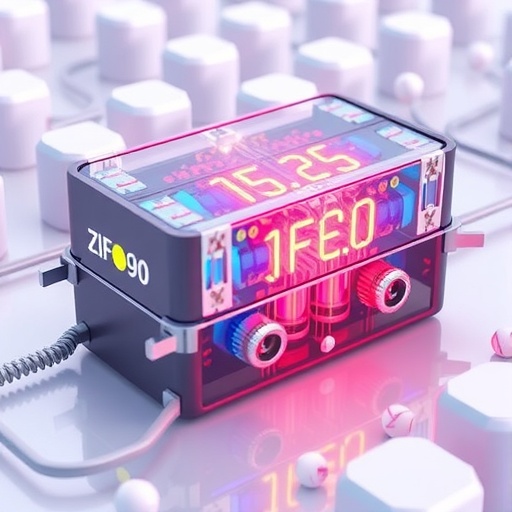In the pursuit of advanced materials for energy storage and conversion, researchers are increasingly turning to novel hybrid systems that offer enhanced performance. A recent study, published in the journal “Ionics,” unveils a next-generation hybrid composed of ZIF-90, Nb₂C, and graphene quantum dots (GQDs). This innovative structure not only serves as a promising candidate for integrated energy storage solutions but also significantly contributes to hydrogen evolution, highlighting its dual functionality in the energy sector.
The advent of metal-organic frameworks (MOFs) and their derivatives has revolutionized materials science. Among these, Zeolitic Imidazolate Frameworks (ZIFs) have gained attention due to their tunable porosity and surface area, making them ideal for gas storage and separation applications. In this context, ZIF-90 stands out for its exceptional stability and structural integrity, providing a robust foundation for the development of hybrid nanostructures that capitalize on its advantageous properties.
Integrating ZIF-90 with Nb₂C, a member of the MXenes family, yields a composite material that extends its functionality into the realm of energy storage. Nb₂C is renowned for its remarkable electrical conductivity and surface area, coupled with its unique layered structure. This combination allows for efficient charge transfer, which is critical for energy storage applications. By forming a hybrid with ZIF-90, the resulting material harnesses the strengths of both components, enhancing overall performance in electrochemical systems.
Incorporating graphene quantum dots (GQDs) adds another layer of sophistication to this hybrid design. GQDs possess exceptional electronic properties, high surface-to-volume ratios, and superior photonic characteristics. These attributes enable GQDs to function as effective dopants, boosting the electric conductivity of the hybrid system and improving its electrochemical activity. This tripartite hybridization not only optimizes charge storage mechanisms but also facilitates easier electron transfer, creating a synergistic effect that amplifies the performance of the material in energy devices.
The innovative ZIF-90/Nb₂C@GQD nanohybrid has shown exceptional promise in various electrochemical tests. Its impressive capacitance makes it suitable for supercapacitors, while its catalytic properties open avenues for applications in hydrogen evolution reactions. Researchers conducted extensive experimentation to evaluate the hybrid’s electrochemical behavior, revealing significant enhancements in both energy storage capacity and hydrogen production efficiency compared to its individual counterparts.
The structure and morphology of the ZIF-90/Nb₂C@GQD nanohybrid were meticulously analyzed using advanced characterization techniques. Transmission electron microscopy (TEM) and scanning electron microscopy (SEM) images exhibit a uniform distribution of both Nb₂C and GQDs within the ZIF matrix. This well-defined architecture facilitates optimal interaction between the components, creating a conductive pathway that enhances electron movement during charge storage and catalytic processes.
Energy density and power density are critical metrics when assessing the performance of energy storage devices. The study details how the novel nanohybrid surpasses standard benchmarks, providing elevated energy density without compromising power delivery. This balance is vital for applications that demand rapid energy discharge, such as in electric vehicles and portable electronics, positioning the ZIF-90/Nb₂C@GQD composite as a leading candidate for future energy solutions.
Furthermore, the hydrogen evolution reaction (HER) capabilities of the ZIF-90/Nb₂C@GQD nanohybrid were thoroughly examined. HER is a key reaction in water-splitting processes for hydrogen production, a clean energy carrier. The hybrid material demonstrated remarkable catalytic activity, significantly reducing the overpotential required for HER, which is a critical factor in boosting the efficiency of hydrogen production systems.
Temperature stability and cycling performance are pivotal factors in determining the longevity and reliability of energy storage systems. The study reported that the ZIF-90/Nb₂C@GQD nanohybrid exhibited outstanding thermal stability even under elevated temperatures, maintaining its structural integrity and electrochemical performance. Additionally, the cycling stability tests indicated minimal performance decay over extended charge-discharge cycles, suggesting that this advanced nanohybrid holds promise for practical, long-term applications in energy storage and hydrogen evolution.
In conclusion, the research presented in the article on ZIF-90/Nb₂C@GQD nanohybrids signifies a substantial leap towards advanced materials in the fields of energy storage and hydrogen production. The unique synergistic interactions between ZIF-90, Nb₂C, and GQDs result in a high-performance composite with significant potential to influence future energy technologies. As the quest for sustainable and efficient energy solutions intensifies, the innovative findings from this study will likely pave the way for the development of next-generation energy devices that harness the full capabilities of these emerging materials.
With global energy demands continuing to rise, the importance of integrating renewable energies and enhancing energy storage solutions has never been more critical. The ZIF-90/Nb₂C@GQD nanohybrid exemplifies the potential of hybrid nanomaterials to address the pressing energy challenges we face. Their remarkable performance attributes hold promise for improving the functionality and efficiency of practical devices, thereby contributing to a sustainable energy future.
The transformative nature of this research not only enhances our understanding of hybrid nanomaterials but also sets the stage for future innovations in the energy sector. As such, continued exploration into the synthesis, optimization, and practical applications of similar materials will be essential for harnessing their full potential and achieving a more sustainable, energy-efficient world.
Subject of Research: Hybrid nanomaterials for integrated energy storage and hydrogen evolution
Article Title: Next-Generation ZIF-90/Nb₂C@GQD nanohybrids for integrated energy storage and hydrogen evolution
Article References:
Albargi, H.B., Zeeshan, M., Abaker, M.E. et al. “Next-Generation ZIF-90/Nb₂C@GQD nanohybrids for integrated energy storage and hydrogen evolution.” Ionics (2025). https://doi.org/10.1007/s11581-025-06799-9
Image Credits: AI Generated
DOI: https://doi.org/10.1007/s11581-025-06799-9
Keywords: ZIF-90, Nb₂C, graphene quantum dots, nanohybrids, energy storage, hydrogen evolution, electrochemistry, sustainable energy solutions.
Tags: advanced energy storage materialsdual functionality of ZIF-90 Nb2Cefficient charge transfer materialsenhanced performance in energy storagegraphene quantum dots in energy applicationshydrogen evolution in nanohybridsinnovative hybrid systems for energymetal-organic frameworks for energy conversionMXenes for energy applicationsstructural integrity in nanomaterialstunable porosity in ZIFsZIF-90 Nb2C hybrid nanostructures





